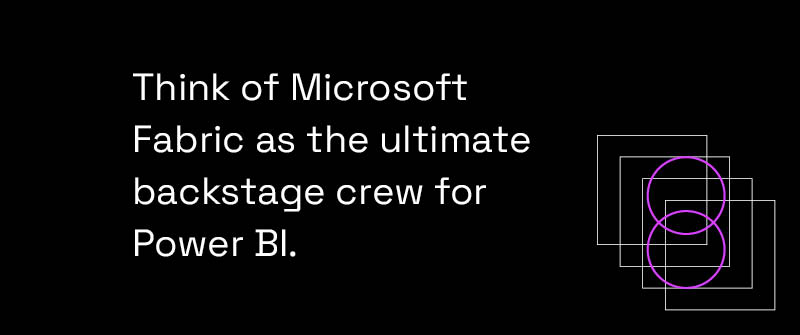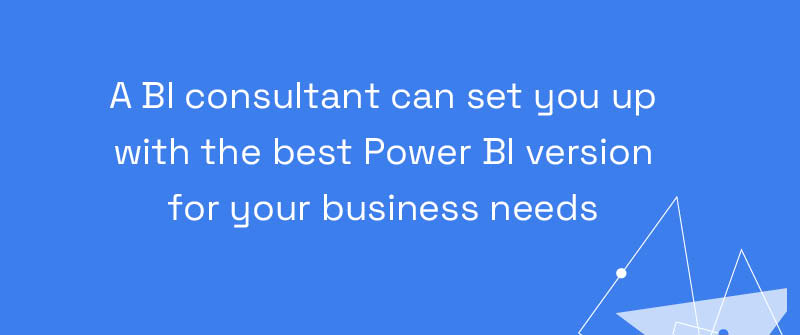
Here’s the thing: traditional BI is kind of like using a flip phone in the age of smartphones. Technically, it works, but it’s far from ideal. Legacy BI creates static dashboards, which are old news before you even get to share them. In addition, traditional BI solutions often struggle with large data volumes and lack of self-service BI, so IT teams can become bogged down helping teams with report creation and finding the answers they need.
Modern BI solutions, like Power BI and Microsoft Fabric, change all that, offering predictive and advanced analytics, speed, scale, and the self-service ability that you need to stay competitive. Microsoft Fabric consulting will not only help develop Power BI dashboards but also partner with you to decide when integrating Fabric makes sense based on your business needs and data strategy. Let’s dig deeper!
Is Microsoft Fabric Needed For Power BI?
You don’t necessarily need Microsoft Fabric to use Power BI. Power BI is already a rockstar as a business intelligence tool—connecting data from various sources and transforming it into interactive reports and dashboards for useful data insights. But if you’re dealing with large datasets, struggling with performance issues, or managing a bunch of disconnected systems, Microsoft Fabric changes the game.
Power BI On Its Own
Power BI began as a standalone SaaS tool, and while it’s now integrated into Microsoft Fabric, it can still be used independently if that’s all you need. Even on its own, Power BI is a powerful business intelligence solution. A skilled BI consultant can build polished reports and dashboards that make data analysis and visualization more accessible across your organization. What makes Power BI so popular? Its intuitive interface, combined with the ability to turn raw data into sleek, interactive visuals, helps teams tell compelling stories with data, regardless of whether they’re presenting to stakeholders, clients, or internal business users.
Microsoft Fabric + Power BI: A Dynamic Duo
Think of Microsoft Fabric as the ultimate backstage crew for Power BI. Together, they form a powerful team when it comes to data analytics. Power BI handles turning your data into easy-to-share reports and dashboards that bring insights for decision-making. Microsoft Fabric supports the entire data lifecycle, bringing together storage, integration, and synapse real time analytics all in one place (no juggling multiple tools). Bring in a Microsoft Fabric consultant, and they’ll integrate the two, giving you the best of both worlds, using Power BI to create insightful data visualizations and integrating Fabric to do the heavy lifting behind the scenes.
In short, integrating Microsoft Fabric with Power BI brings some serious value—unlocking advantages like real-time analytics, enhanced collaboration, and AI-powered insights. For example, Power BI can help insurance companies streamline claims management and improve risk assessment, while healthcare professionals can use it to optimize staffing or easily view patient care satisfaction. With Fabric in the mix, these insights get a major boost by improving dashboards, enhancing the user experience, and making data transformation seamless across different sources.
However, setting all this up isn’t just a plug-and-play situation. You’ll want a Microsoft Fabric consultant to help configure everything properly. They can fine-tune your setup, optimize dataflows, and make sure Power BI and Fabric are working together like the ultimate rock band, with powerful data tools working behind the scenes.

Will Microsoft Fabric Replace Power BI?
Microsoft Fabric is not here to replace Power BI, it’s here to expand what’s possible with data. Power BI has been the go-to tool for data visualization and BI for quite some time. A bit of the newer kid on the block, Microsoft Fabric is a unified data platform. It’s like the backbone that makes working with data smoother by ingesting, transforming, storing, and analyzing data before it even reaches Power BI, while Power BI remains the front-end tool that brings those insights to life.
In the world of business intelligence (BI), Fabric and Power BI have their own strengths but work even better together. A Microsoft Fabric consultant helps ensure you can tap into this game-changing team. Power BI makes data easy to view and understand, with reports and dashboards that help teams make better, faster decisions. Fabric works behind the scenes and is designed for businesses that have massive amounts of data across multiple platforms. It brings together synapse data engineering, real-time analytics, and AI-driven insights in one place.
So, no, Fabric won’t replace Power BI. It’s an important tool within the Microsoft Fabric umbrella. A consultant can set you up with Power BI on its own as a powerful data visualization and reporting tool, or they can come in and help you tap into Fabric’s broader data analytics capabilities to take your business intelligence to the next level. The real question is: Would my business benefit from using Power BI as a part of Fabric? A consultant can help you answer that question and help you bring complete analytical capabilities to your organization.
What is the Difference Between Fabric Workspace and Power BI Workspace?
In general, workspaces in both platforms are places to collaborate with teams to create collections of items such as reports, lakehouses, and warehouses, as well as to create task flows. A consultant will partner with you to create workspaces that best fit your business needs and to facilitate data activator workflows as needed.
The difference is that Power BI workspaces are designed for business intelligence. They’re a place for creating, sharing, and managing reports, dashboards, and structured data models. They’re great for teams who need to visualize data, track key features, and work together with insights.
Microsoft Fabric acts as an all-in-one analytics hub, bringing together all the reporting and dashboard features of Power BI but also adding real-time analytics, data engineering, AI/ML tools, and data warehousing. It’s a one-stop shop for managing and analyzing data at scale. And if you’re familiar with the Power BI user experience, Fabric has the same look and feel, making core features like workspaces (among others) easy to use for existing Power BI users.
Power BI and Fabric workspaces both use role-based access and permissions, but Fabric’s roles go beyond BI to support all the other pieces we mentioned above. Let’s break it down:
- Admin – In both, the admin has full control over settings, users, and security. In Fabric, this includes managing capacity, workloads, and OneLake storage.
- Member – Can create, edit, and manage content in both platforms. In Fabric, this extends beyond reports to data pipelines, warehouses, and AI tools.
- Contributor – Can create and edit content but can’t manage users or settings. This works the same in both Power BI and Fabric.
- Viewer – A viewer in both platforms has read-only access to view reports and data without making changes.
So, if your team is focused on Power BI reports and dashboards, the Power BI workspace roles will be enough. But if you’re working with big data, AI, and advanced analytics, Fabric workspaces give you more control over data processes and governance.
Everything Has Pros and Cons
When setting up Power BI and Fabric, a consultant will look at your organization’s needs and each platform’s advantages and limitations to create workspaces that will best empower your teams. Here’s a look at the pros and cons of each:
Power BI Workspaces
Pros:
· Great for reporting and visualization. Perfect for creating clear, interactive dashboards.
· User-friendly for analysts and easy to collaborate with teams.
· Works well with structured data for focused business intelligence.
Cons:
· Separate data storage instead of a centralized system, which can complicate things.
· Licensing and capacity are tied to Power BI.
Fabric Workspaces
Pros:
· Built for big data. Supports BI, data science, engineering, and AI all in one place.
· Uses OneLake for centralized data storage and integration.
· Better management and security for enterprise-scale collaboration.
Cons:
· More complex—requires more technical know-how than Power BI.
· Not necessary for teams focused only on reporting and visualization.
· Requires Fabric capacity, which impacts licensing and budgeting.
Which Version of Power BI Is Best?
The Power BI version you choose comes down to who’s using it and what you need to do. Are you a solo user or just getting started? Downloading the free version of Power BI might be enough. You can connect to data and build reports and dashboards, but you won’t be able to share them with others. Great for personal projects but not so much for teamwork.
For businesses, Power BI Pro is the way to go. It lets you share reports, collaborate with your team, and connect to tons of data sources. The catch? You can only share and collaborate with Pro users who have a Power BI license.
If you’re working with huge datasets, need advanced AI features, or want enterprise-level performance, Power BI Premium could be the sweet spot. A Power BI Premium per user license (PPU) unlocks extra features, but you can only collaborate with others who have the same license. A Premium (capacity-based) license lets Pro or PPU users create content in Premium workspaces and share it with anyone, whatever their license type.
A BI consultant can set you up with the best Power BI version for your business needs, whether it be going with Power BI Pro for everyday reporting or diving into Microsoft Fabric if you’re dealing with massive data and need serious analytics power.

Where Does Fabric Fit In?
With Microsoft Fabric in the mix, your decision shifts a bit. Since Power BI is now part of the broader Fabric ecosystem, organizations using Fabric for big data, AI, and analytics may find Power BI Premium a better fit because it integrates seamlessly with Fabric’s lakehouse architecture and advanced analytics tools. But if you’re sticking to traditional reporting, Pro might still be the best value.
If you’re still unsure which way to go, you’re not alone; it can be tough to know which path fits your goals, tech stack, and team. But going back to our flip phone reference, traditional BI may be working fine for you, but modern BI solutions like Power BI and Microsoft Fabric offer so much more. Businesses of all sizes can benefit from having their data all in one place, real-time, self-service analytics, and reports and visuals that drive data-driven decision-making.
Here’s where we come in. Whether you’re exploring a full modern data stack or looking to get more out of the tools you already have, our BI and Microsoft Fabric experts will walk through the pros and cons based on your specific goals, explain your options, and guide you to the solution that makes the most sense for your business. Let’s chat!
Get in touch with a P3 team member